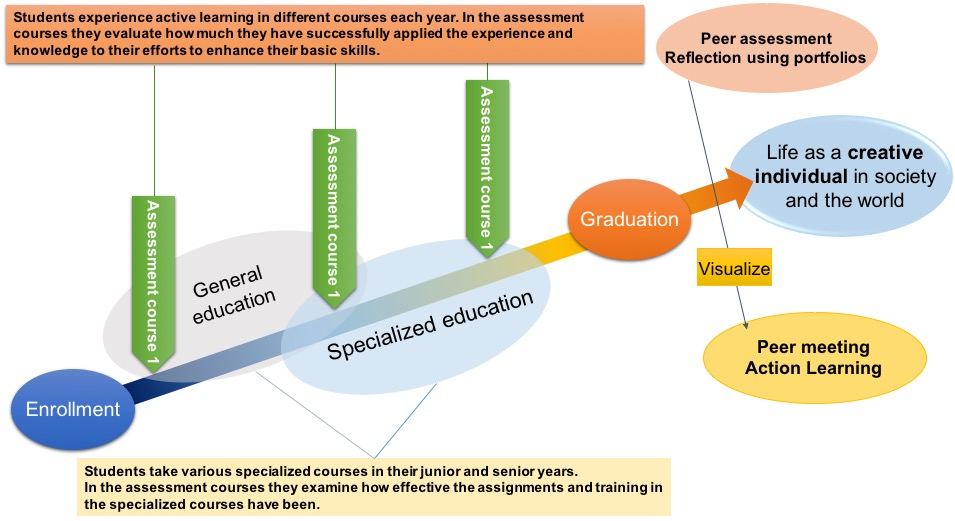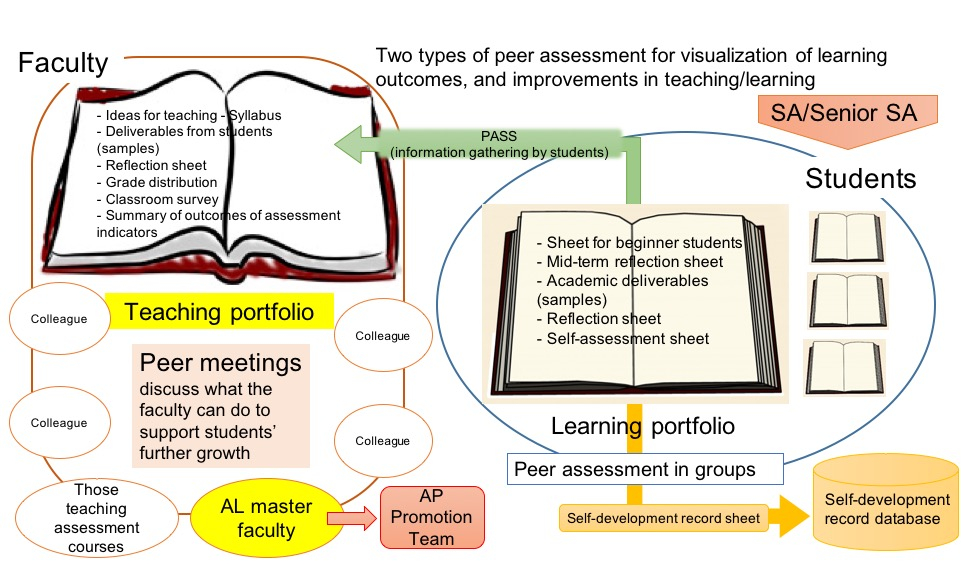- Acceleration Program for University Education Rebuilding (AP)
- Important Points in AP
Important Points in AP
1. The Concept of the Self-Assessment Rubrics in the Assessment Gates
Soka University believes that active learning will help students not only to boost their intellectual ability and academic performance, but also to grow as individuals. We consider growth as a developmental process that consists of three stages. The first stage is enrollment in the university (“milestone”), the second is the effort toward independent learning (“touchstone”), and the third is the effort to become creative individuals (“capstone”).
We will develop and introduce rubrics on the assumption that they will be used for assessment as a form of learning, or learning through assessment. More precisely, each student will use the rubrics as he/she experiences self-assessment as the chart shows.
We will develop and introduce rubrics on the assumption that they will be used for assessment as a form of learning, or learning through assessment. More precisely, each student will use the rubrics as he/she experiences self-assessment as the chart shows.

Self-assessment in first year
Students’ skills and attitudes are visualized as the foundation of their academic learning.
Students assess their own visualized outcomes and refer back to the evaluation as they set their academic goals in the coming years.
This is the first assessment gate.
Self-assessment in sophomore and junior years
Students need a course and assignments that allow them to try the skills (i.e. basic skills) they have acquired on their learning paths so far.
In the assessment course, students check the levels of their basic skills.
Self-assessment in the second half of the junior year and the whole of the senior year
We will offer a course designed to give students opportunities to voluntarily use the expertise they have acquired, and to assess their own skills needed for its use, along with what they hope to do with their expertise. Students approaching graduation take this assessment course in which they work on assignments and activities designed to help them reflect back on their learning outcomes of specialized and general education courses, as well as on the activities they have engaged in.
Students’ skills and attitudes are visualized as the foundation of their academic learning.
Students assess their own visualized outcomes and refer back to the evaluation as they set their academic goals in the coming years.
This is the first assessment gate.
Self-assessment in sophomore and junior years
Students need a course and assignments that allow them to try the skills (i.e. basic skills) they have acquired on their learning paths so far.
In the assessment course, students check the levels of their basic skills.
Self-assessment in the second half of the junior year and the whole of the senior year
We will offer a course designed to give students opportunities to voluntarily use the expertise they have acquired, and to assess their own skills needed for its use, along with what they hope to do with their expertise. Students approaching graduation take this assessment course in which they work on assignments and activities designed to help them reflect back on their learning outcomes of specialized and general education courses, as well as on the activities they have engaged in.
2: What Students and Faculty Do for Self-Assessment
Peer assessment using portfolios
The assessment courses require students to set their goals in the beginning of the semester and to conduct mid-term and final assessments.
Students each use a worksheet to work in groups to present their own efforts.
The assessment courses require students to set their goals in the beginning of the semester and to conduct mid-term and final assessments.
Students each use a worksheet to work in groups to present their own efforts.

1. Teaching portfolios and peer meetings
2. The assessment courses require students to create portfolios as a tool for self-assessment. Students refer to their learning outcomes in the portfolios as they assess their own efforts.
2. The assessment courses require students to create portfolios as a tool for self-assessment. Students refer to their learning outcomes in the portfolios as they assess their own efforts.
3: Faculty Training
We provide intensive faculty training during the summer vacation and spring break to ensure the quality of our faculty’s teaching.
In the training, participants acquire knowledge needed for the program, such as how to use backward design for teaching, how to use portfolios, and what instructions to give for active learning.
In the training, participants acquire knowledge needed for the program, such as how to use backward design for teaching, how to use portfolios, and what instructions to give for active learning.
